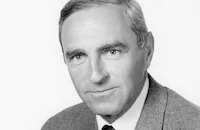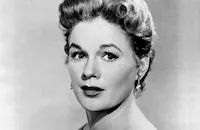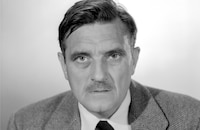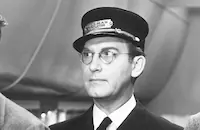Arena

Brief Synopsis
Cast & Crew
Richard Fleischer
Gig Young
Jean Hagen
Polly Bergen
Henry Morgan
Barbara Lawrence
Film Details
Technical Specs

Synopsis
After taking part in a drag race, rodeo rider Hob Danvers shows up at "La Fiesta de los Vaqueros" rodeo in Tucson, Arizona, with his high-spirited girl friend, Sylvia Lorgan. There they encounter Hob's old friends, Lew and Meg Hutchins, who are staying in a trailer with their young son Teddy. Lew, an aging veteran of the rodeo circuit, tells Hob he has come to ask rodeo owner Eddie Elstead for a job. Hob is then visited by his estranged wife Ruth, whom he has not seen in two years. Although she still loves Hob, Ruth despises the unstable lifestyle of the rodeo cowboy, and when she asks for a divorce, Hob hides his own emotions and consents. After losing most of his money in a dice game, Hob meets Lew at his trailer and is appalled to find his friend dressed up as a clown. Lew explains that it was the only job Eddie could give him and that he intends to do it well. The rodeo begins, and after commiserating with Meg, Ruth decides to leave. Meanwhile, rising rodeo star Jackie Roach makes a pass at Sylvia, but she rejects him. Hob rides very well in the bareback event, earning him Teddy's admiration. Jealous that Hob has become his son's hero, Lew pays an injured cowboy to let Lew take his place in the upcoming bronco-riding event. Ruth then returns to the stands, and enjoys the unnerving effect her presence has on Sylvia. The bronco-riding event begins, and Lew is thrown from the bucking animal and injures his knee. When Lew clutches his leg in pain, the crowd roars, assuming it is part of his act, and Hob rushes to his aid. Eddie angrily berates Lew, but Meg and Hob praise his performance until Ruth demands that they stop lying to him and face the fact that Lew is washed up. Hob sends Ruth away, but Lew is impressed by her courage and tells Meg to bring her back. Lew then tries to convince Hob to make up with Ruth, and when Sylvia objects, Lew strikes her. Lew then returns to the ring for the dangerous Brahma bull event, ignoring Meg's objections. Hob is the last contestant, and Sylvia's excitement at seeing him risk his life fills him with disgust. Hob is quickly thrown by the fierce bull, and while Lew is distracting the animal, his injured knee acts up, and he is gored to death as his wife and son look on in horror. As Meg bemoans Lew's senseless death, Hob tells Sylvia they are through, and she leaves with Jackie. Hob is standing alone in the empty ring when Ruth approaches him, and they leave the arena arm in arm.

Director

Richard Fleischer
Cast

Gig Young

Jean Hagen

Polly Bergen

Henry Morgan

Barbara Lawrence

Robert Horton

Lee Aaker

Lee Van Cleef
Marilee Phelps
Jim Hayward
George Wallace
Stuart Randall

Morris Ankrum
Dale Van Sickel
Archie Butler
Chuck Hayward
Dick Farnsworth
Billy Dix
Marshall Reed

Emmett Vogan
Helen Spring
Jesse Kirkpatrick
Jean Dante
John Nedloe
Mary Lawrence
Chris Olsen
John Call
Len Hendry
Murray Alper
Crew
Harold Jack Bloom
Alvord Eiseman
Cedric Gibbons
A. Arnold Gillespie
Sydney Guilaroff
Rudolph G. Kopp
Arthur M. Loew Jr.
Arthur M. Loew Jr.
Richard Pefferle
Merrill Pye
Douglas Shearer
Marvin Stuart
William Tuttle
Paul C. Vogel
Charles Wallace
Cotton Warburton
Edwin B. Willis

Film Details
Technical Specs

Articles
Arena (1953)
by Glenn Erickson

Arena (1953)
Quotes
Trivia
Notes
According to a October 7, 1952 Hollywood Reporter news item, Keenan Wynn was originally cast in a leading role. Arena was M-G-M's first feature-length stereoscopic, or "3-D," film. A May 14, 1953 Hollywood Reporter news item noted that the film was being referred to as the screen's first "round" Western. Spurred by competition both from television and the other studios, M-G-M developed its own stereoscopic process, Metrovision Tri-Dee; however, the studio released only one other 3-D film, Kiss Me Kate (see below).
According to a March 27, 1953 news item in Hollywood Reporter, Arena and all future films released in Ansco color would share color credit with Technicolor. Portions of the film were shot on location at the annual "La Fiesta de Los Vaqueros" rodeo in Tucson, AZ. According to a Hollywood Reporter news item, the film had a 15-city premiere on June 19, 1953. For more information on 3-D films, see the entry below for Bwana Devil.














